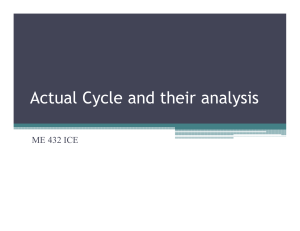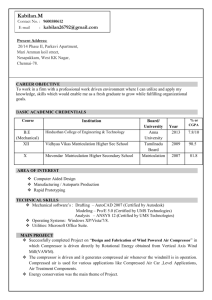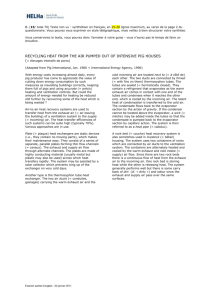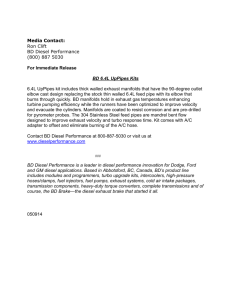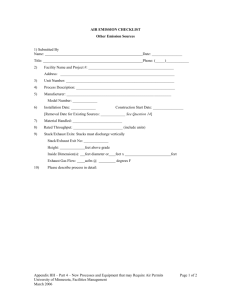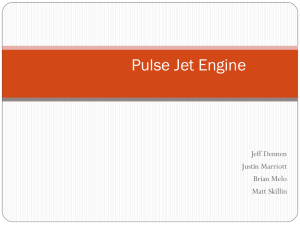6 Actual Cycles
advertisement
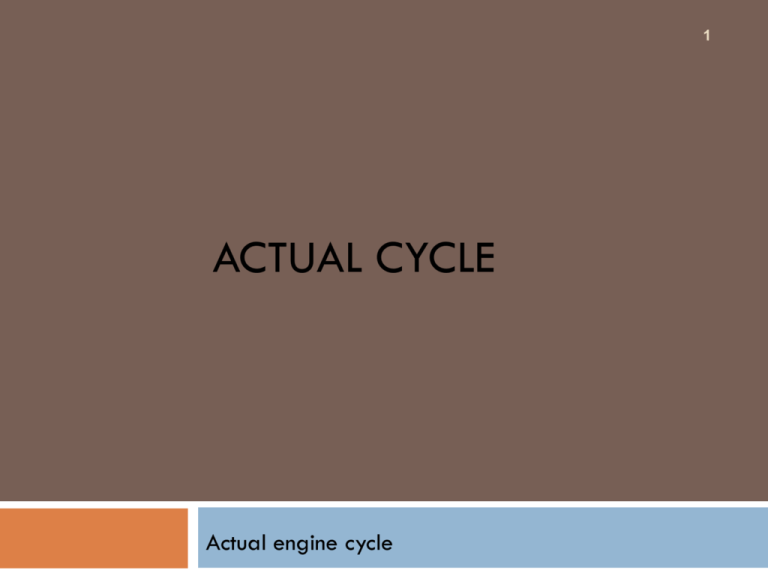
1 ACTUAL CYCLE Actual engine cycle Introduction 2 Ideal Gas Cycle (Air Standard Cycle) Idealized processes Idealize working Fluid Fuel-Air Cycle Idealized Processes Accurate Working Fluid Model Actual Engine Cycle Accurate Models of Processes Accurate Working Fluid Model Introduction Air-Standard Cycle Analysis gives an estimate of engine performance which is much greater than the actual performance, For Example for SI Compression ratio Thermal Efficiency Air-Standard Cycle 7:1 Actual Engine Cycle 7:1 55 % 28% 3 Introduction 4 The actual cycles for IC engines differ from the fuel-air cycles and air- standard cycles in many respects. The actual cycle efficiency is much lower than the air-standard efficiency due to various losses occurring in the actual engine operation. The major losses are due to: Variation of specific heats with temperature Dissociation of the combustion products Progressive combustion Incomplete combustion of fuel Heat transfer into the walls of the combustion chamber Blowdown at the end of the exhaust process Gas exchange process Introduction 5 Theoretical Cycle I Corrected for the Characteristics of the Fuel-Air Air Cycle Composition of Cy. Gases Variable sp.heat, Dissociation etc.. II Fuel-Air Cycle IV Useful work Actual work loses Less the friction losses gives III Actual Cycle modified to account for Combustion loss, Time loss, Heat loss Blowdown loss, etc… Comparison Of Air-standard And Actual Cycles 6 The actual cycles for internal combustion engines differ from air- standard cycles in many respects i. The working substance being a mixture of air and fuel vapor or finely atomized liquid fuel in air combined with the products of combustion left from the previous cycle. ii. The change in chemical composition of the working substance. iii. The variation of specific heats with temperature. iv. The change in the pressure, temperature and actual amount of fresh charge because of the residual gases 7 Comparison Of Fuel-Air Cycle And Actual Cycles v. The progressive combustion rather than the instantaneous combustion. vi. The heat transfer to and from the working medium vii. The substantial exhaust blowdown loss, i.e., loss of work on the expansion stroke due to early opening of the exhaust valve. viii. Gas leakage, fluid fiction etc., in actual engines. Points (i) to (iv), are similar to fuel-air cycles Points (v) to (viii) are the difference between fuel-air cycles and actual cycles. The Major Loss of Actual Cycle 8 Time loss factor Heat loss factor Loss due to time required for mixing of fuel and air and also for combustion. Loss of heat from gases to cylinder walls. Exhaust blowdown factor Loss of work on the expansion stroke due to early opening of the exhaust valve. Time Loss Factor 9 In air-standard cycles the heat addition is an instantaneous process whereas in an actual cycle it is over a definite period of time. The crankshaft will usually turn about 30 to 400 b/n the initiation of the spark and the end of combustion (time loss due to progressive combustion) Time Loss Factor 10 Due to the finite time of combustion, peak pressure will not occur when the volume is minimum (TDC) but will occur some time after TDC The pressure, therefore, rises in the first part of the working stroke from b to c as shown in Fig. This loss of work reduces the efficiency and is called time loss due to progressive combustion. Time Loss Factor 11 The time taken for combustion depends upon The flame velocity which in turn depend up on the type of fuel and the fuel-air ratio The shape and size of the combustion chamber. The distance from the point of ignition to the opposite side of the combustion space In order that the peak pressure is not reached too late in the expansion stroke, the time at which the combustion starts is varied by varying the spark timing or spark advance. Time Loss Factor 12 Figure below shows the effect of spark timing on p-v diagram from a typical trial. With spark at TDC (0o spark advance), the peak pressure is low due to the expansion of gases. Time Loss Factor 13 If the spark is advanced to achieve complete combustion close to TDC additional work is required to compress the burning gasses 35o Spark advance Time Loss Factor 14 With or without spark advance the work area could be less and the power output and efficiency are lowered. Therefore a moderate or optimum spark advance (15o30o) is the best compromise resulting in minimum losses on both the compression and expansion strokes Time Loss Factor 15 Table shows the engine performance for various ignition timings (rc =6). The effect of spark advance on the power output by means of the p-V diagram Time Loss Factor 16 The effect of spark advance on imep and power loss Time Loss Factor 17 Some times a deliberate spark retarded from optimum may be necessary in order to • avoid knocking • reduce exhaust • reduce emission of hydrocarbons and carbon monoxide Time Loss Factor 18 At full throttle with the fuel-air ratio corresponding to maximum power and with the optimum ignition advance, the time losses may account for a drop in efficiency of about 5 percent for actual Engine 2 percent fuel-air cycle efficiency These losses are higher when the mixture is richer or leaner Ignition advance is not optimum and at part throttle operations the losses are higher. Time Loss Factor 19 It is impossible to obtain a perfect homogeneous mixture with fuel-vapor and air, since, residual gases from the previous are present in the clearance volume of the cylinder. further, very limited time is available between the mixture preparation and ignition Under these circumstances, it is possible that a pocket excess oxygen is present in one part of the cylinder and a pocket of excess fuel in another part. Therefore, some fuel does not or burns partially to CO and the unused O2 appears in the exhaust Time Loss Factor 20 ... Composition exhaust gases for various fuel-air ratio Time Loss Factor 21 Only about 95 % of the energy is released with stoichiometric fuelair ratios. Energy released in actual engine is about 90% of fuel energy input. It should be noted that it is necessary to use a lean mixture to eliminate wastage of fuel, while a rich mixture is required to utilize all the oxygen. Slightly leaner mixture would give maximum efficiency but too lean a mixture will burn slowly increasing the time losses or will not burn at all causing total wastage of fuel In a rich mixture a part of the fuel will not get the necessary oxygen and will be completely lost. Time Loss Factor 22 The flame speed in mixtures more than 10% richer is low, thereby, increasing the time losses and lowering the efficiency. Imperfect mixing of fuel and air may give different fuel-air ratios during suction stroke or certain cylinders in a multi cylinder engine may get continuously leaner mixtures than others. Heat Loss factor 23 During combustion the heat flows from the cylinder gases through Cooling water Lubricating oil Conduction and convection and radiation Heat loss during combustion will have the maximum effect on the cycle efficiency Heat Loss factor 24 The effect of heat loss during combustion reduce the maximum temperature and therefore the specific heats are lower. Out of various losses heat losses contribute around 12 % For further details, read John B. Heywood, chapter 12 (page 668- 711) Exhaust Gas Blowdown The actual exhaust process consists of two phases: P i) Blowdown PT ii) Displacement i e i Products State 6 (TC) State 5 (BC) Blowdown Displacement Blowdown – At the end of the power stroke when the exhaust valve opens the cylinder pressure is much higher than the exhaust manifold pressure which is typically at 1 atm (P4 > Pe), so the cylinder gas flows out through the exhaust valve and the pressure drops to Pe. 25 Displacement – Remaining gas is pushed out of the cylinder by the piston from BDC moving to TDC. Exhaust Gas Blowdown 26 When to open the exhaust valve? The cylinder pressure at the end of expansion stroke is high as 7 bar depending on the compression ratio employed. If the exhaust valve is opened at BDC, the piston has to do work against high cylinder pressure during the early part of the exhaust stroke If the exhaust valve is opened too early, a part of the expansion stroke is lost The best compromise is to open the exhaust valve 400 to 700 before BDC thereby reducing the cylinder pressure to halfway (say 3.5 bar) before the exhaust stroke begins Exhaust Gas Blowdown P5 = Pe = P6 , T5 = Te = T6 P T5 = T4 5 P4 k −1 k P = T4 e P4 k −1 k m6 m6 V6 v6 1 v4 = = = m1 m4 V4 v4 rc v6 1 T P 1 T P = 4 6 = 4 6 rc T6 P4 rc T5 P4 f = The residual gas temperature T6 is equal to T5 T5 P5 = T4 P4 since f = 1 k k −1 P = 6 P4 k 1 P5 1P = e rc P4 rc P4 1 k k −1 k Blowdown Displacement 27 TC BC Exhaust Gas Blowdown 28 Loss due to Gas Exchange process (pumping loss) The work done for intake and exhaust stroke cancelled each other The pumping loss increased at part throttle, because throttling reduce the suction pressure Pumping Pumping loss also increase with speed loss affect the Volumetric efficiency when Pi less than Pe Exhaust Gas Blowdown Unthrottled (WOT): Pi = Pe = 1 atm EV opens imep = Throttled: Pi < Pe W5−6−1 = ( Pi − Pe )Vd EV closes IV opens W3−4 − W1−2 IV closes (state1) Vd EV opens EV closes Pumping work IV closes 6’ IV opens Supercharged: Pi > Pe IV opens 6’ 1 29 EV closes Exhaust Gas Blowdown 30 Volumetric efficiency affected by The density of fresh charge The exhaust gas in the clearance volume The design of intake and exhaust manifold The timing of intake and exhaust valves Volumetric Efficiency The density of fresh charge As the fresh charge arrives in the hot cylinder, heat is transferred to it from The hot chamber walls The hot residual gases Temperature rise reduces the density , which decrease the mass of fresh charge admitted and a reduction in volumetric efficiency The volumetric efficiency increased by Low temperature High pressure of fresh charge 31 Volumetric Efficiency 32 Exhaust gas in the clearance volume The residual gas occupy a portion of piston displacement volume, thus reducing the space available to the incoming charge. These exhaust products tend to rise the temperature of the fresh charge. Volumetric Efficiency 33 The design of intake and exhaust manifold The exhaust manifold should be designed to enables the exhaust products to escape readily, The intake manifold should be designed so as to bring in maximum possible fresh charge flowing in to the cylinder Volumetric Efficiency 34 The timing of intake and exhaust valves Valve timing is the regulation of the points in the cycle at which the valves are set to open and close. Valves requires a finite period of time to open or close for smooth operation Volumetric Efficiency 35 The effect of intake valve timing on the engine air capacity is indicated by its effect on the air inducted per cylinder, per cycle. The intake valve timing for both a low and high speed SI engine For low speed Opening @10o before TDC Closing @10o after BDC Volumetric efficiency 36 For high speed Opening @10o before TDC Closing @60o after TDC Loss due to Running Friction 37 The losses are due to friction between the In piston and the cylinder walls various bearings Energy spent in operating the auxiliary equipment (cooling pump, ignition system, fan…) The piston ring friction increases rapidly with engine speed. Loss @ part and Full load r=8 38
